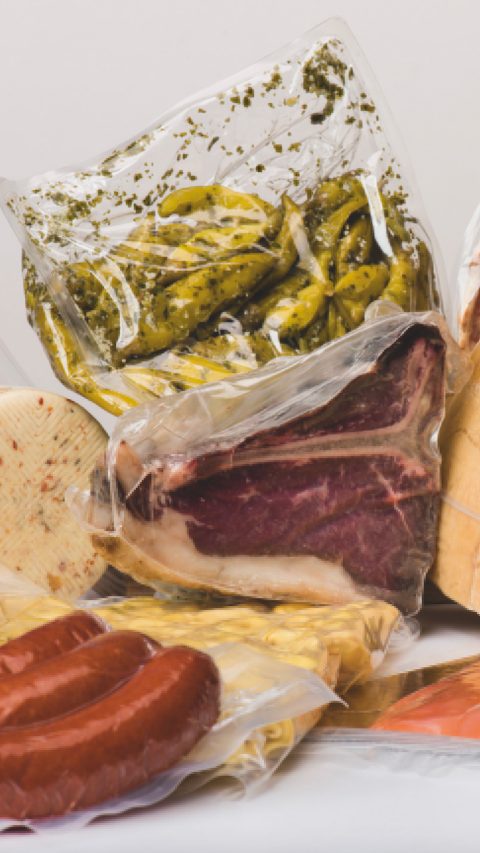Polyamides for Extrusion
Ultramid® extrusion grades are offered in a wide variety of combinations of viscosity and additives.
Their outstanding properties have made them indispensable for transparent and flexible food packaging, medical packaging, monofilament applications (e.g. fishing lines, fishing nets, lawn trimmers) and cable sheathing.
Applications
Ultramid® B (homopolyamide PA6) grades
| Ultramid® | melting point | viscosity number | relative viscosity | additives | applications |
| Ultramid® B33 L |
220°C | 195 | 3.3 | lubricant | BOPA, paper coating monofilaments |
| Ultramid® B36 L | 220°C | 218 | 3.6 | lubricant | blown film, casing, water cooled film |
| Ultramid® B36 LN | 220°C | 218 | 3.6 | lubricant, nucleating agent |
cast film |
| Ultramid® B36 LNV | 220°C | 218 | 3.6 | lubricant, nucleating agent |
cast film |
| Ultramid® B40 | 220°C | 250 | 4.0 | blown film, monofilaments | |
| Ultramid® B40 L | 220°C | 250 | 4.0 | lubricant | blown film, casing, monofilaments |
| Ultramid® B40 LN | 220°C | 250 | 4.0 | lubricant, nucleating agent |
cast film (blown film) |
Ultramid® slow crystallisation grades
| Ultramid® | melting point | viscosity number | relative viscosity | additives | applications |
Ultramid® B36 SL |
215°C | 218 | 3.6 | lubricant | |
| Ultramid® B36 SLN | 215°C | 218 | 3.6 | lubricant, nucleating agent |
cast film, blown film, extrusion lamination |
Ultramid® C (copolyamide PA6/66) grades
| Ultramid® | melting point | viscosity number | relative viscosity | additives | applications |
Ultramid® C33 |
196°C | 195 | 3.3 | blown film, monofilaments | |
Ultramid® C33 L |
196°C | 195 | 3.3 | lubricant | blown film |
Ultramid® C33 LN |
196°C | 195 | 3.3 | lubricant, nucleating agent | blown film |
Ultramid® C37 LC |
182°C | 225 | 3.7 | lubricant | monofilaments, blown film, shrink film |
Ultramid® C37 LXC |
182°C | 225 | 3.7 | lubricant | monofilaments |
Ultramid® C40 L |
189°C | 225 | 4.0 | lubricant | monofilaments, blown film, shrink film |
Ultramid® C40 LN |
189°C | 225 | 4.0 | lubricant, nucleating agent | blown film |
Ultramid® C40 LX |
189°C | 225 | 4.0 | lubricant | monofilaments |

| Polyamide type | ||
| B | = |
PA 6 |
C |
= |
copolyamide 6/66 |
Viscosity class Relative viscosity in 96%/23°C sulphuric acid (i.e 36 for RV 3.6). * Except Ultramid Flex F38, measured in different solvent. |
||
| 33 | = |
intermediate viscosity |
36 |
= |
intermediate to high viscosity |
37 |
= |
high viscosity |
| 38 | = | high viscosity |
| 40 | = | high viscosity |
| Additive | ||
| L | = |
lubricated |
LC |
= |
clear |
LN |
= |
lubricated and nucleated |
| LNV | = | lubricated and nucleated, reduced residual caprolactam level |
| LX | = | high gloss and transparency |
| S | = | slow crystallisation |
Example
B40 LN (PA6, high viscosity, lubricated, nucleated)
Supply form and storage
Ultramid® is supplied as pre-dried pellets ready for processing in a variety of moisture-proof containers such as bags, octabins, big bags and loose bulk.
To ensure that the perfectly dry material delivered cannot absorb moisture from the air, the containers must be stored in dry rooms and always carefully resealed after any material is removed. Containers stored in cold rooms should be allowed to equilibrate to normal temperature before opening so that no condensation occurs on the pellets.
Safety precautions during processing
Like all thermoplastic polymers, Ultramid® also decomposes when exposed to excessive heat, such as overheating or cleaning by burning off, forming gaseous decomposition products. As well as caprolactam (with Ultramid® B (PA 6) and C (PA 6/66)), ammonia and carbon monoxide are formed above approximately 310°C. Above approximately 350°C, small quantities of pungent-smelling vapors of aldehydes, amines and other nitrogenous decomposition products are also formed.
In general, measures should be taken to provide ventilation and venting of the workplace, preferably by means of an extraction hood over the cylinder unit.
Food regulations
Information regarding the food approval status of Ultramid® and other plastics is available under menu item Sustainability – Product safety and environment.




